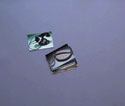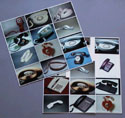|

|
CHAPTER
4  pdf (1.2 Mb)
pdf (1.2 Mb)
The theoretical framework was then brought into the realm of an
actual design situation (Chapter 4). In a design experiment the
effects of providing designers with precedent designs as reference
material, while working on a design task, were studied. Two ways
of organizing the provided precedents, random vs. typological, were
compared. The subjects, all senior students of Industrial Design
Engineering in Delft, were given the task to design a ‘mobile
telephone for a female executive’. |

|
|


" Random" group
|
PROCEDURE
During this task the subjects could draw reference to a collection
of product examples. For half of the subjects these examples were
organized into five product types, while the other half was given
the same examples as an unorganized collection. Before the start of
the actual design task, all subjects were asked to draw from memory
their concept of a mobile telephone. This drawing was then labelled
as the subject's pre-concept. Next the subjects were given the design
brief, together with the product examples. At the end of the session,
which lasted 90 minutes, they were asked to produce a drawing of their
final concept, which was labelled as their post-concept. Pre-concepts
and post-concepts were then assessed in a paired-comparison to compare
the performances of both groups. |


"Typological" group
|
| |
RESULTS
It was hypothesized that providing subjects with product examples
which were organized in product types would results in design concepts,
that in their appearance reflected, to a greater extent, the features
of the provided types. This turned out to be true for those types
that were in line with the given design brief. In these cases the
products that make up for the type were used as confirming examples,
forming a positive frame of reference. When a product type was not
in line with the brief, it seemed to function in just the opposite
way, with the products in them acting as contrasting examples, resulting
in design concepts in which the features of the type were much less
present. It was also expected that through their problem-independent
nature the product types would reduce the effect of fixation, being
a designer’s adherence to his preconceived ideas regarding the
product form as represented by his pre-concept. The subjects who received
the product types showed much more development in their design process,
in a direction that was expected considering the design brief, than
the subjects who were provided with the unorganized product examples.
IMPLICATIONS
In all, the results of the experiment showed that providing designers
with typologically organized design knowledge in the form of product
types has a beneficial effect on the results of their design process.
Extending these results to the development of computer support tools
led to the concept of a visual database of design precedents that
are organized into types according to the three product typologies.
Such a database would provide the designer with a valuable body
of design knowledge to consult during the design process. However,
rather than developing a database that is presented to designers
as a complete collection of pre-organized product types, it was
argued that a database that is essentially organized, maintained
and extended by designers themselves, would have an important additional
value. Further, it would force designers to attentively observe
and compare products on different levels of detail and abstraction,
thus enhancing their sensitivity for design details and nuances.
|
"Typological"
Pre Post
|
|
